

Climate Action - District of Squamish - Hardwired for Adventure. The Earth’s temperature is regulated by a delicate balance of atmospheric gases that trap heat from the sun and make life thrive—these heat trapping gases are called greenhouse gases, and this is called the greenhouse effect.
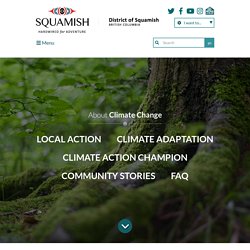
Water vapour, carbon dioxide and methane are the primary greenhouse gases. Carbon exists on Earth naturally too, and is stored in plants, ground soil, and the ocean. Industrial activity, such as clear-cutting forests and burning fossil fuels, has released too much carbon dioxide and methane into the atmosphere, causing the temperatures of the Earth to rise.
This shift in weather patterns is referred to as climate change or global warming. The Domino EffectAs the Earth warms, natural systems are disrupted, which leads to extreme weather events such as hurricanes and wildfires. We must take urgent action to slow and then stop global warming. OpenTreeMap Open Source - Mapping all the trees of the world, one at a time! Surrey sustainability dashboard. Inclusion A caring community that encourages a sense of belonging and access to opportunity for all Surrey residents to realize their full potential.
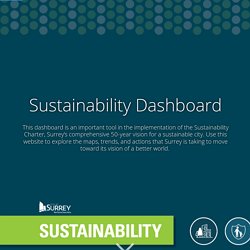
Built Environment and Neigbourhoods A beautiful, accessible and well-connected city of distinct and complete neighbourhoods that are walk-able, engaging and resilient. Protecting Surrey's Urban Forest. Shade Tree Management Plan.
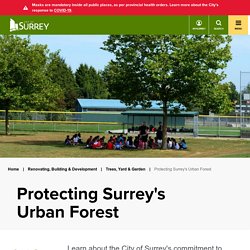
Trees for Tomorrow. What is Trees for Tomorrow?
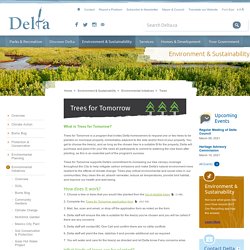
Trees for Tomorrow is a program that invites Delta homeowners to request one or two trees to be planted on municipal property, immediately adjacent to the side and/or front of your property. Urban Reforestation Project. Delta's Urban Reforestation Project: increasing trees via new plantings throughout our urban communities The Urban Reforestation Project is an active tree planting initiative launched by the City in 2015 to increase Delta’s tree canopy coverage at a variety of park, school and roadway sites.
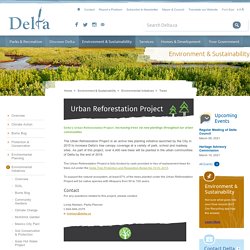
As part of this project, over 4,400 new trees will be planted in the urban communities of Delta by the end of 2019. The Urban Reforestation Project is fully funded by cash provided in lieu of replacement trees for trees cut under the Delta Tree Protection and Regulation Bylaw No 7415, 2015. To support the natural ecosystem, at least 67% of the trees planted under the Urban Reforestation Project will be native species with lifespans from 50 to 100 years. Contact For any questions related to this project, please contact:
Urban Forests. Urban Forest Climate Adaptation Initiative The term ‘urban forest’ describes trees in parks, around buildings, along streets and in backyards.

In the Metro Vancouver region there are also remnant patches of forest. Home - Green Infrastructure Ontario. Green infrastructure is defined as the natural vegetative systems and green technologies that collectively provide society with a multitude of economic, environmental and social benefits.
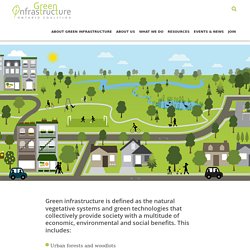
This includes: Urban forests and woodlotsBioswales, engineered wetlands and stormwater pondsWetlands, ravines, waterways and riparian zonesMeadows and agricultural landsGreen roofs and green wallsUrban agricultureParks, gardens and grassed areas It also includes soil in volumes and qualities adequate to sustain green infrastructure and absorb water, as well as technologies like porous pavements, rain barrels and cisterns, which are typically part of green infrastructure support systems. Our purpose - Nature4Climate : Nature4Climate. Natural climate solutions can provide a third of the cost-effective climate mitigation needed between now and 2030 to meet the goals of the Paris climate agreement.
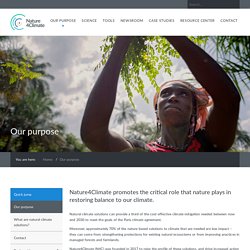
Moreover, approximately 70% of the nature-based solutions to climate that are needed are low impact – they can come from strengthening protections for existing natural ecosystems or from improving practices in managed forests and farmlands. Topic Catalog. Climate Data Canada. Global Greenhouse Gas Emissions Data. On This Page: Global Emissions by Gas At the global scale, the key greenhouse gases emitted by human activities are: Carbon dioxide (CO2): Fossil fuel use is the primary source of CO2.
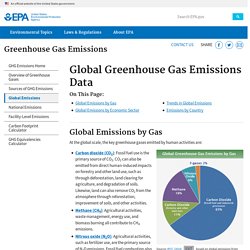
Tree planting 'has mind-blowing potential' to tackle climate crisis. Planting billions of trees across the world is one of the biggest and cheapest ways of taking CO2 out of the atmosphere to tackle the climate crisis, according to scientists, who have made the first calculation of how many more trees could be planted without encroaching on crop land or urban areas. As trees grow, they absorb and store the carbon dioxide emissions that are driving global heating. New research estimates that a worldwide planting programme could remove two-thirds of all the emissions from human activities that remain in the atmosphere today, a figure the scientists describe as “mind-blowing”.
The analysis found there are 1.7bn hectares of treeless land on which 1.2tn native tree saplings would naturally grow. That area is about 11% of all land and equivalent to the size of the US and China combined. Tropical areas could have 100% tree cover, while others would be more sparsely covered, meaning that on average about half the area would be under tree canopy. Just Have a Think - climate change youtube.
Carbon Footprint Calculator. Carbon footprint food transpo. Heat Pumps. What on Earth are 'natural climate solutions'? Editor’s note: From “climate adaptation” to “blue carbon,” environmental jargon is everywhere these days.
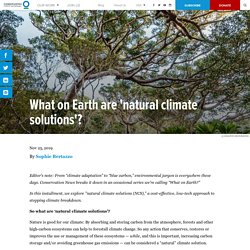
Conservation News breaks it down in an occasional series we’re calling “What on Earth?” In this installment, we explore "natural climate solutions (NCS)," a cost-effective, low-tech approach to stopping climate breakdown. 16 ways to take action on climate. These actions, derived from experts and research by the United Nations Environment Programme (UNEP) alongside others, are featured as part the Count Us In campaign, a diverse coalition of culture, faith, sport, cities and businesses. Organizers hope the activities and support of the partners will inspire one billion people to take practical steps to reduce carbon pollution and challenge leaders to act more boldly on climate.
Individual action can make a significant impact. Count Us In organizers estimate that if 1 billion people take practical action in their own lives, they could reduce as much as 20 per cent of global carbon emissions. “We are in the midst of three planetary crises – the climate crisis, the nature crisis, and the pollution and waste crisis. Nature-based solutions for climate change: from global ambition to local action. Regional Climate Advisors. As a PCP member, you can access free support and services from our Regional Climate Advisors.
They’ll help you understand where your community has opportunities to reduce greenhouse gas emissions (GHGs) as it moves through the five steps of the PCP program’s Milestone Framework. Work with an advisor from your region who understands your local context and is regularly in touch with governments and the private sector about local sustainability, energy planning and climate change issues. Their services are free to PCP members, and include: Teams of Regional Climate Advisors are available across the country. Connect with the team lead in your region today: Fifty Ways to Bring More Urgency to BC’s Climate Action Plans. For a printable PDF of this paper, click Download “We are facing a disaster of unspoken suffering for enormous amounts of people, so please, treat the climate crisis like the acute crisis it is, and give us a future.” – Greta Thunberg For years, Guy Dauncey has tirelessly warned of the urgency of tackling the climate crisis and provided practical ways to achieve reductions in our emissions.
CCH Captains' Calls - Running Notes. Community Climate Hub.